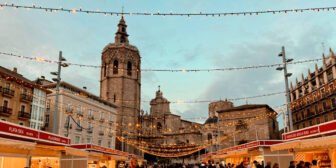Valencia or Alicante? Which Spanish city should you visit next? They are both located on the shores of the Mediterranean Sea and are among the sunniest cities in Europe (Alicante ranks #1 and Valencia #6). But at the same time, Valencia and Alicante offer different travel experiences and this makes them both appealing tourist destinations.
The third largest city in Spain, Valencia has a marked cosmopolitan feel with beautiful architecture, a wide range of cultural attractions, and endless entertainment options. Alicante, on the other hand, is considerably smaller, has a more relaxed Mediterranean vibe, stunning coastal scenery, and a beautiful sandy beach right next to the city center.
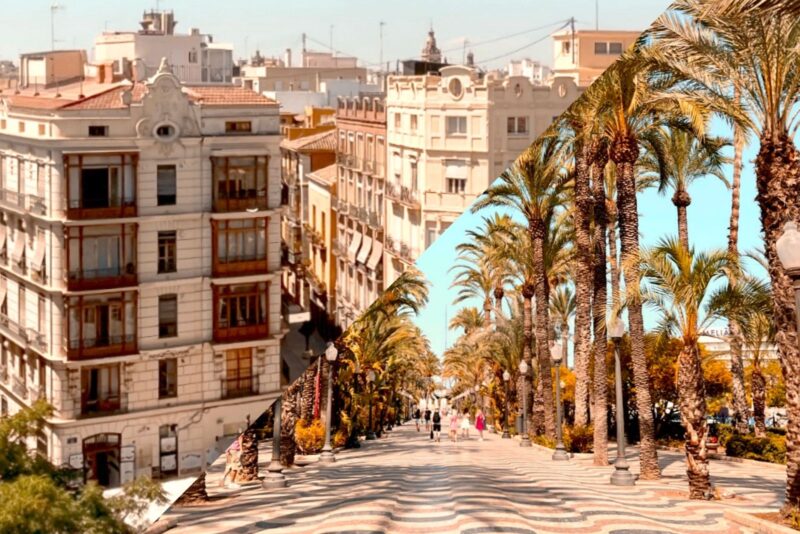
So which city is better to visit – Valencia or Alicante? The answer to this question might not be straightforward as it greatly depends on what type of vacation you’re looking for.
Valencia and Alicante are 170 km apart (that’s 2 hours by train or car), so you could consider a vacation that includes them both. For example, you could visit first one and then the other. Or you could base yourself on one and visit the other on a day trip.
Set to visit only one of them? Then read on, as I’ll provide (more or less) unbiased opinions of Valencia vs. Alicante to help you choose the best city for your holiday. I’ve been living in Valencia for years and visited Alicante many times, so I have a fairly comprehensive understanding of both cities.
In This Article
Alicante or Valencia for convenience of travel
Valencia

Valencia’s modern airport is situated 8 km west of the city. It is equipped with e-passport gates and mobile boarding pass scanners and it handles a wide range of domestic and international flights to nearly 100 destinations in Europe and northern Africa. Many of these flights are operated by low-cost airlines.
Getting from Valencia Airport to the city center is super easy and fast. Simply hop on the metro and you’ll be in the city center in as little as 20 minutes. If for whatever reason you prefer the bus, line 150 stops right in front of arrivals.
Valencia is connected to Madrid, Cuenca, Segovia, Córdoba, Sevilla, Málaga, and other Spanish cities via high-speed train. The journey from Madrid to Valencia takes as little as 1 h 50 min, making Valencia a great day trip from Madrid (see my one-day in Valencia itinerary) and vice versa. On the other hand, the train journey from Barcelona to Valencia takes 2 h 50 min.
Valencia is connected to the Balearic Islands by sea. There are high-speed ferries from Valencia to Ibiza, Mallorca, and Menorca, as well as Formentera (with a change en route).
Alicante
Alicante is also well-connected by air through the Alicante-Elche Airport, situated 12 km south of the city. Alicante is the gateway to Costa Blanca and has flights to over 120 destinations in Europe and northern Africa, many of them operated by low-cost airlines.
A whopping number of these flights connect Alicante with cities all over the UK. One caveat, however, is that some of these flights are only operational during the summer season.
To get from Alicante airport to the city center you need to take a taxi or bus. Bus line C6 connects the airport to the Luceros TRAM station, a light rail that links Alicante to various cities and towns along Costa Blanca, such as Benidorm, Calp, and Dénia.
Alicante has direct train connections with several cities in Spain such as Madrid, Barcelona, Valencia, Bilbao, Santander, and A Coruña. Getting from Madrid to Alicante on AVE high-speed train takes 2 h 30 min. Reaching Alicante from Barcelona takes over 5 hours.
🏆 Winner: Valencia (but Alicante is not far behind)
Alicante or Valencia for ease of moving around the city
Valencia

Valencia is a very walkable city that is best explored on foot. Most attractions are within walking distance from each other, however, there are some instances when you might want to use public transport (such as when you’re in the city center and want to go to the beach).
Valencia has a modern and efficient public transport system that makes it easy to move around. It includes buses, trams, and metros, providing good coverage to all neighborhoods. To make sense of Valencia’s public transport network, including opening hours and the types of tickets available, read my guide to using public transport in Valencia.
Biking is another popular and convenient way of exploring Valencia. The city is as flat as a paella pan and has a top-notch cycling infrastructure, with over 175 km of bike lanes. Besides, Valencia has a great number of bike rental shops and a bike-sharing system called Valenbici. Bike rental in Valencia usually starts at €10 per day.
Alicante
Alicante’s city center is compact and pedestrian-friendly, making it easy to explore on foot. Many of the city’s main attractions are located in and around the historic old town (Barrio de Santa Cruz) and are within walking distance of each other. However, expect to have to climb some stairs when exploring this area as many streets are uphill.
If you need to use public transport, the bus might be your best bet. Alicante has a well-developed and affordable bus network that serves the city and its metropolitan area.
Alicante also has a modern tram network, but the tram is more useful for traveling along the coast and reaching nearby towns like Villajoyosa or Altea than moving within the city. As a bonus, lines L1 and L9 offer great scenic views of the coastline, which is quite nice.
Alicante is less bike-friendly compared to Valencia. That’s because Alicante is a bit hilly and it also has way fewer bike lanes. If you wish to cycle along the promenade, which is flat, it’s not impossible to find a bike rental shop. However, you might want to consider renting an electric bike instead.
🏆 Winner: Valencia
Alicante or Valencia for tourist attractions
Valencia
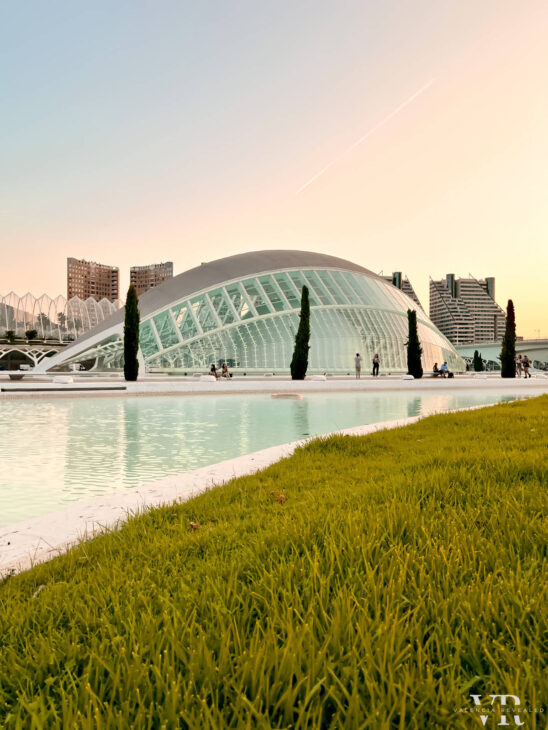
Valencia has lots of tourist attractions. Top of the list is the City of Arts and Sciences, a futuristic architectural complex designed by Santiago Calatrava. This attraction is unique in the world and when it was inaugurated at the end of the 20th century, it single-handedly put Valencia on the tourist map.
Another big tourist draw is the Old Town. This historic part of Valencia features charming narrow streets, picturesque squares, and relaxing sidewalk cafés.
Among the most noteworthy landmarks in this area are the Valencia Cathedral (home of the Holy Grail), the stunning Central Market (a wonderful example of Valencian Art Nouveau), and La Lonja de la Seda (a UNESCO World Heritage site).
Valencia also has many beautiful churches, engaging museums, and plenty of green spaces. One of the city’s most unusual attractions is the Túria Park, which was built in the former riverbed of the Túria River. This lush green ribbon embraces the Old Town and is one of the largest urban parks in Spain.
Alicante
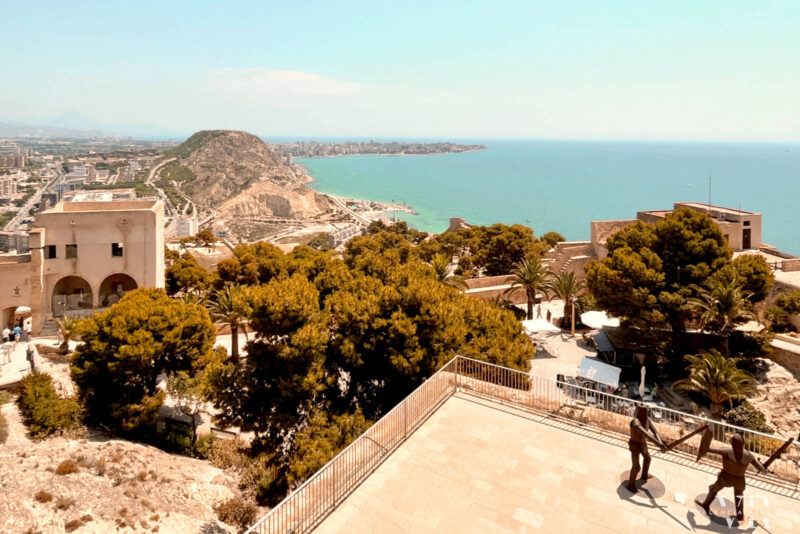
Alicante has fewer tourist attractions compared to Valencia, but even if fewer, they are different enough to make Alicante a tourist destination in its own right.
The main attraction in Alicante is the Santa Barbara Castle, a historic fortress that sits atop Mount Benacantil. From up here visitors can enjoy amazing panoramic views of Alicante and the Mediterranean Sea. Plus you don’t have to break a sweat to get to the top as there’s an elevator carved into the mountain!
Another attraction is Barrio de la Santa Cruz, the oldest part of the city and its most famous neighborhood. It has narrow streets, whitewashed houses decorated with colorful flower pots, and a small village feel that’s just surreal.
Alicante also has several museums, albeit less important than the ones in Valencia, and a beautiful City Hall building. Explanada de España, Alicante’s iconic promenade lined with palm trees and vibrant outdoor cafés is another major draw for tourists.
🏆 Winner: Valencia
Alicante or Valencia for beaches
Valencia
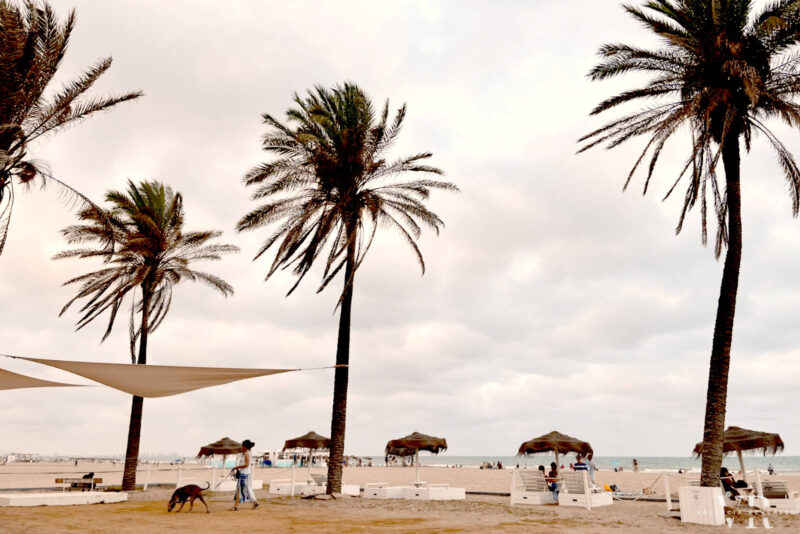
Valencia has three beautiful urban beaches that seamlessly blend into each other and stretch for over 3.5 km. They all have fine golden sand and two of them (El Cabanyal and Malvarrosa Beach) have been granted Blue Flag status.
What I love about Valencia’s beaches is that they are super wide and rarely feel crowded. The El Cabanyal beach is a whopping 200 meters wide stretch of sand in parts!
Due to the width of these beaches, there’s always a buffer between beachgoers and people taking a leisurely walk on the promenade, granting plenty of privacy to the former. There’s also plenty of space for playing beach sports without bothering anyone.
Valencia’s urban beaches are dotted with chiringuitos (beach bars). The promenade is lined with restaurants serving anything from paella and tapas to fancy cocktails.
A great number of these restaurants have undergone a major facelift in recent years and look modern and sleek and, dare I say, pretty darn amazing. In my opinion, Valencia’s beach restaurants are mature, elegant, and chic without any hint of kitsch, which I love.
On top of that, the nearby marina is one of the best nightlife spots in Valencia.
The only caveat is that Valencia’s beaches are a bit far from the center. Ultimately, Valencia is a city with a beach (or three) and not a beach with a city.
From the city center, you can get to the beach in under half an hour. Depending on where you’re staying in Valencia, you’ll have to take the bus, metro, or bike. That’s because walking from most neighborhoods, the city center included, takes too long.
While I normally recommend staying in the city center, if you love spending time on the beach and this is a priority for you, booking your accommodation in the El Cabanyal neighborhood can make more sense for you.
Alicante
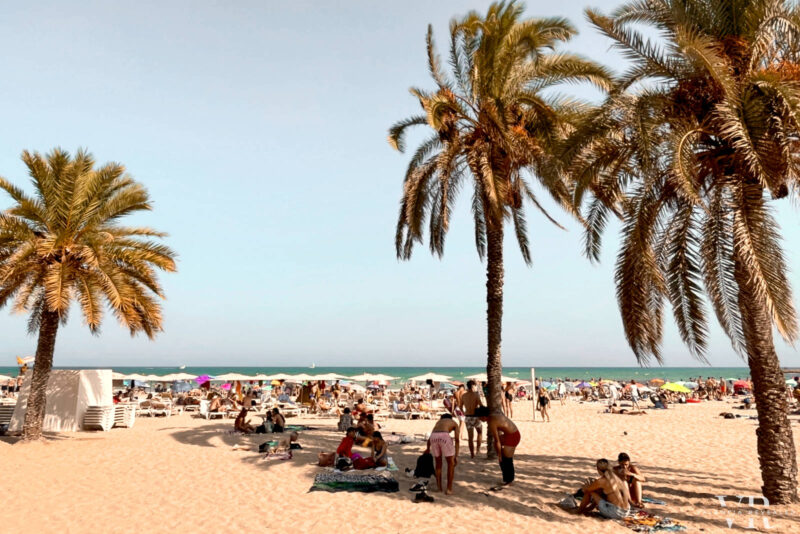
Due to its location on Costa Blanca, Alicante is particularly renowned for its stunning surrounding coastline, although its six urban beaches are pretty cool as well. Not to mention that three of them – Playa de Postiguet, Playa de Albufereta, and Playa de San Juan – have been granted Blue Flag status.
Alicante’s biggest asset is Playa de Postiguet which is located in the heart of the city, right at the base of the Santa Barbara Castle. Unlike Valencia’s beaches, this beach can be easily reached on foot from the city center and the historic Santa Cruz neighborhood.
Postiguet is a beautiful sandy beach with a pretty promenade nearby, but it’s nowhere near as wide as the beaches of Valencia. The promenade has several terraces where you can enjoy a drink with a view. If you don’t mind having the hordes of passersby staring at you while you sunbathe, then you’ll love it here.
Another popular beach is Playa de San Juan to the north. This beach is situated in a residential area, a few kilometers away from the city center, and can be reached by public transport in half an hour.
Playa de San Juan is a 2.2 km stretch of fine golden sand and clear waters. It is wider and nicer than Playa de Postiguet and less crowded. It’s also family-friendly and has plenty of restaurants and bars nearby, although depending on where you’re sitting, you might have to walk a bit to the nearest one.
Playa de San Juan is flanked by Playa de Muchavista to the north and Playa de las Huertas to the south. Together, they are 7 km long.
🏆 Winner: Alicante (for beaches within walking distance from the city center)
Alicante or Valencia for food and drinks
Valencia
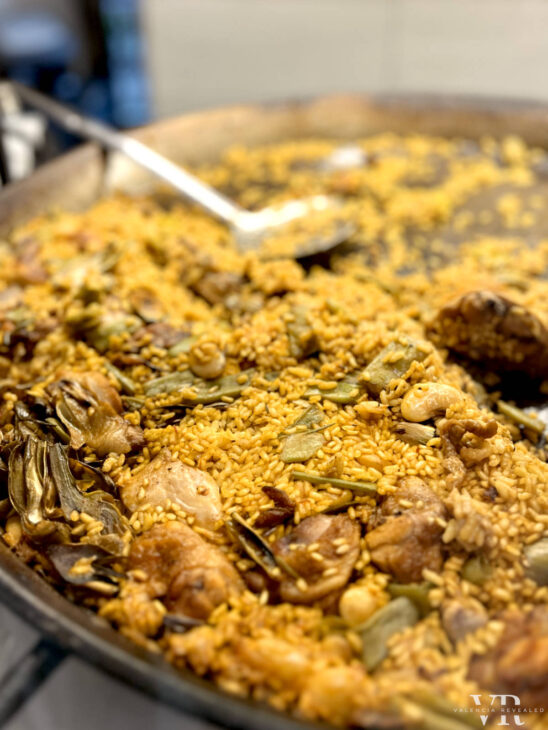
Valencia is the birthplace of paella and the home of horchata (a sweet and refreshing drink made with tiger nuts) so it’s really difficult to top that. It’s also home to Mercado Central (the largest fresh produce market in Europe), several gastro markets, and more than 4,000 restaurants, bars, and cafés (as per Tripadvisor).
Given its “cradle of paella” status, Valencia has more paella restaurants than any other city in the world. It also has many historical horchaterias where you can enjoy the best horchata.
Valencia’s proximity to the sea also means you’ll find plenty of restaurants serving fresh seafood and a myriad of seafood dishes, such as titaina and esgarraet. Other foods you must try in Valencia include clochinas (small local mussels) and fideúa.

If you like beer, you will enjoy Valencia’s beer scene characterized by a wide offering of locally brewed craft beers of the most varied, from orange and rosemary-infused flavors to beers made with chufa (tiger nuts).
Valencia has a flourishing coffee culture, with dozens of places serving amazing specialty coffee. And for a mid-afternoon pick-me-up, Agua de Valencia, a delicious cocktail born in the city decades ago, is a must-try.
Brunch in Valencia has also become a thing in recent years, with plenty of elegant places offering menus of the most varied.
If you have a sweet tooth, you’ll find plenty of local desserts to try. Then wash everything down with local wines from Valencia and Utiel-Requena regions (both with Protected Denomination of Origin status) and other typical Valencian drinks.
Alicante

Alicante is the birthplace of turrón (Spanish nougat made with almonds and honey) and is famous for its arroz a banda (a seafood rice dish somewhat similar to paella). It has over 1,600 restaurants, bars, and cafés listed on Tripadvisor, which is a just slightly lower number of establishments per capita compared to Valencia.
The highest concentration of restaurants are in the city center, the Santa Cruz neighborhood, and along the promenade. Here you can definitely find some interesting-looking places, but even so, Alicante lacks the abundance of cool places Valencia has.
Being a coastal city, Alicante offers a wide selection of fresh seafood but it has also mastered the art of salt-cured fish dishes, such as mojama de atún.
Other local specialties include olleta alicantina (a stew made with legumes, rice, vegetables, and sometimes pork) and arroz con costra (an oven-baked rice and pork dish with a top crust of beaten eggs).
While there are many types of turrón in Spain, the two most popular ones both come from Alicante. They are known as hard turron or turrón de Alicante and soft turrón or turrón de Jijona (a small town 25 km north of Alicante). This popular sweet treat is typically eaten during the Christmas season.
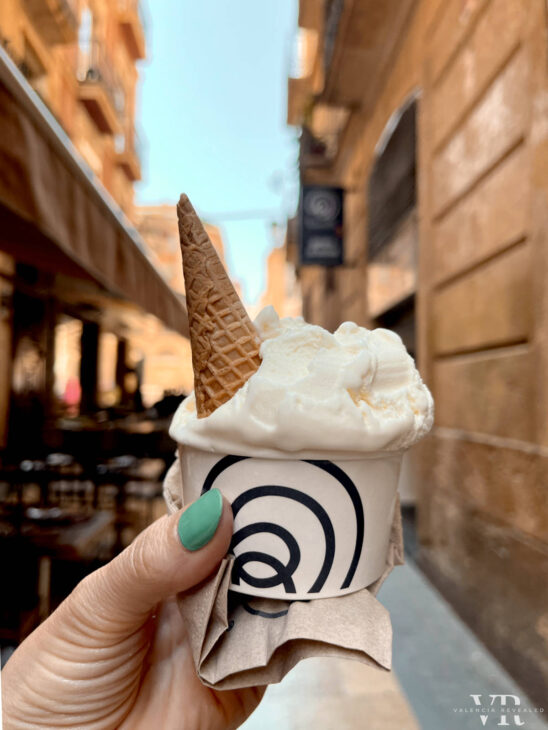
If you visit during the summer months, you might have a hard time finding turrón. But the good news is that Alicante is replete with amazing artisanal ice cream shops. Some of the best are situated in the Santa Cruz neighborhood and you’ll be pressed to find one that doesn’t sell turrón ice cream, among a myriad of other flavors.
On top of that, Valor, the biggest chocolate producer in Spain, is located in Villajoyosa, some 36 km north of the city. This town has three other smaller chocolate factories so you can bet your socks you’ll find some amazing chocolate shops in Alicante.
Alicante also has a small wine region that has been designated Protected Denomination of Origin.
🏆 Winner: Valencia (because there’s barely anything you can find in Alicante that you can’t find in Valencia)
Alicante or Valencia for shopping
Valencia
Valencia has a great fashion scene, with a good mix of Spanish and international brands, trendy boutiques, and designer shops. The main shopping streets are Calle Colón and Calle Juan de Austria in the city center.
El Carmen and Ruzafa neighborhoods are popular with fashion enthusiasts looking for unique items and quirky finds. Both these neighborhoods boast an eclectic mix of independent shops, vintage stores, and concept boutiques.
Valencia also has several commercial centers and five El Corte Inglés department stores. El Corte Inglés is the only department store in Spain and a great place to go shopping for luxury brands. If you’re visiting from abroad, check to see if you qualify for an in-store tax refund.
Mercado Central and the surrounding streets are great for buying souvenirs from Valencia.
Also read: The Best Places to Go Shopping in Valencia
Alicante
Alicante is also good for shopping but has a smaller and more compact shopping area compared to Valencia. This is not necessarily a bad thing, especially when you’re pressed for time.
Shops in Alicante are concentrated along Avenida Maisonnave, Avenida Alfonso el Sabio, and Rambla de Méndez Núñez. Here you can find a mix of international brands, local boutiques, and two El Corte Inglés department stores.
Barrio de Santa Cruz is great for handmade stuff and souvenirs as it has several charming artisan shops selling crafts, ceramics, and accessories.
🏆 Winner: Valencia
Alicante or Valencia for festivals
Valencia

Valencia organizes many festivals and events to the point that it feels like there’s always something going on in the city.
The city’s most important festival, Las Fallas, takes place in March. It features enormous paper-mâché sculptures, firecracker shows, colorful parades, and around-the-clock street parties. After 19 days of celebrations, the festival culminates with an emotional evening of bonfires. Learn more about Las Fallas.
Not long after Las Fallas, Valencia celebrates Semana Santa Marinera with hours-long parades on the streets of the El Cabanyal neighborhood. Semana Santa Marinera is an interesting twist on the Holy Week celebrations taking place throughout Spain. Learn more about Easter in Valencia.
In June, the Night of San Juan is a magical way of welcoming the arrival of summer as people light bonfires along the beach, creating a captivating atmosphere.
Another noteworthy festival is the Gran Feria de Julio, a month-long celebration taking place in July. It features countless free concerts, shows, fireworks, and cultural activities and ends with an epic flower battle.
Christmas is yet another exciting time to visit Valencia. The city organizes several Christmas markets, but there are many more Christmassy things to do in the city.
Also read: 5 Festivals in Valencia You Cannot Miss
Alicante
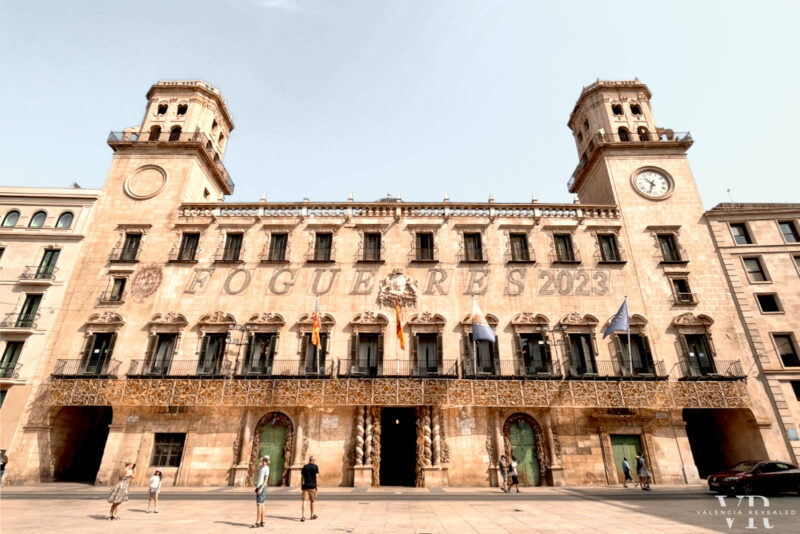
Alicante is not on par with Valencia when it comes to festivals, but it does have one noteworthy fiesta – Hogueras de San Juan.
The Hogueras de San Juan takes place from the 20th to the 24th of June and features large satirical paper-mâché sculptures similar to those you can see in Valencia during Las Fallas. The festival also includes fireworks, firecrackers, lively street parties, and impressive bonfires.
Alicante organizes various other smaller celebrations and parades throughout the year. Most of them have religious origins and offer an opportunity to partake in the local traditions.
Such festivals include the Carnaval (February or March, depending on the year), Romería de Santa Faz (March or April, depending on the year), Semana Santa (during the Holy Week), Moros y Cristianos (July and August), and of course, Christmas.
🏆 Winner: Valencia
Alicante or Valencia for day trips
Valencia

Valencia is a great base for day trips, however, not all interesting places around Valencia can be reached by train or bus. This makes renting a car somewhat of a necessity.
Yet, some day trips from Valencia are surprisingly easy. One example is the Albufera Natural Park, known for its picturesque lake, lush green rice fields, and the village of El Palmar where the paella was born. Another one is the town of Alboraya, known for its chufa, the tuber from which horchata is made.
The rice fields of Albufera and the chufa fields of Alboraya have some of the best biking routes in Valencia. And surprise, surprise… there are bike lanes from the city center going all the way through these fields. Valencia is just bike-friendly like that!
Other fun day trip destinations include the historic cities of Xàtiva, Sagunto, and Gandia. However, you can also visit Madrid on a day trip from Valencia, as well as the small but mighty city of Teruel.
Also read: 10 Easy Day Trips From Valencia You Cannot Miss
Alicante
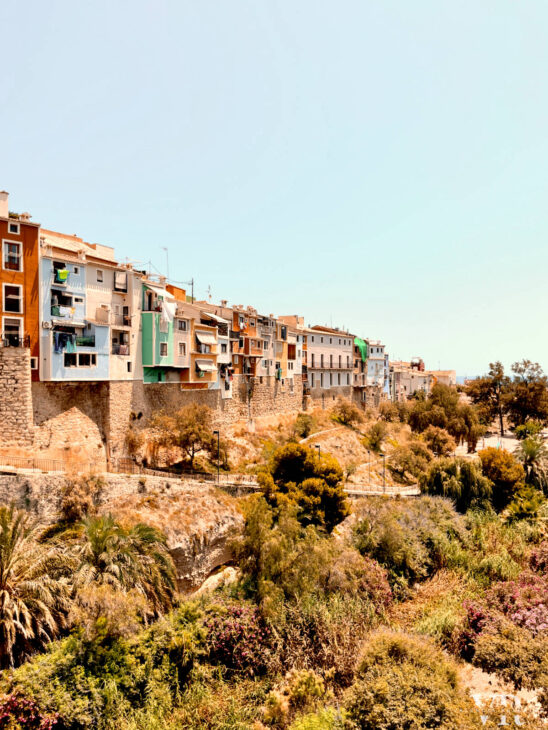
Alicante offers an opportunity to explore the beautiful Costa Blanca. While renting a car is advisable, many beautiful places can be reached by bus or TRAM.
One of the best day trips from Alicante is Villajoyosa, a gorgeous coastal village with colorful architecture. The fact that it’s the birthplace of Chocolates Valor and home to four chocolate factories that you can visit doesn’t hurt either.
From Alicante, you can easily visit Altea and Guadalest, considered two of the most beautiful villages in Spain.
Calp, Xàbia, Dénia, and the resort city of Benidorm with its tacky skyscrapers, are also within easy reach.
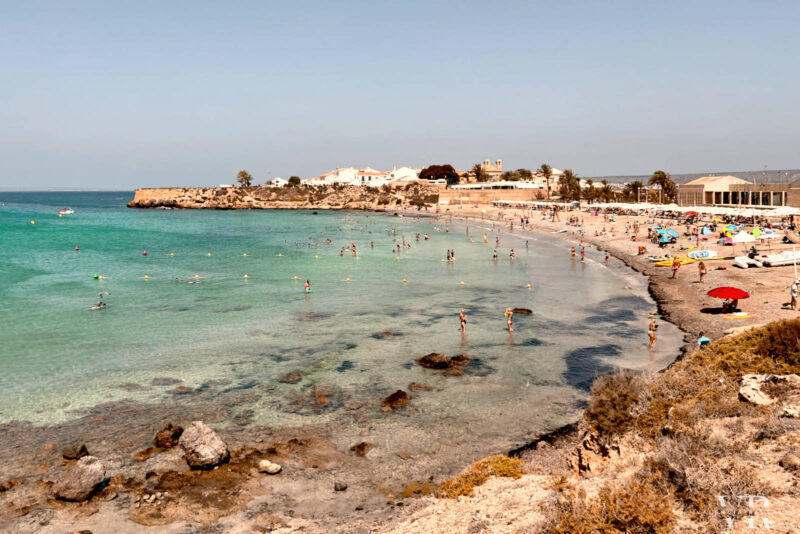
Another wonderful place to visit from Alicante is the Island of Tabarca, a marine reserve with crystal-clear waters and the only inhabited island in the Valencian Community. This island can be visited by ferry from the port of Alicante.
Last but not least, you cannot miss the Canelobre Caves, a beautifully lit cathedral-like cave situated at 700 meters altitude.
🏆 Winner: Alicante
Alicante or Valencia for budget travelers
Valencia
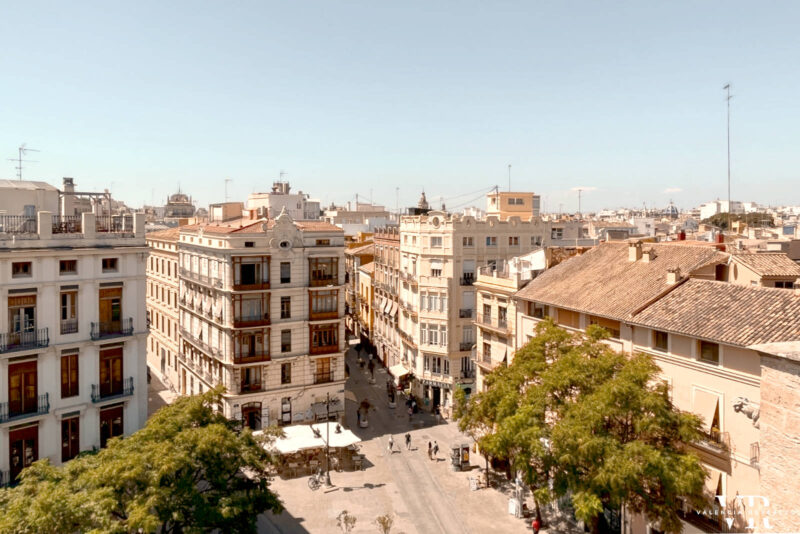
Given that Valencia is the third largest city in Spain, it offers an extensive array of accommodations and dining options to suit all budgets. Public transportation is also affordable, although rarely necessary.
Valencia has over 1,700 hotel and vacation rentals listed on Booking.com (with many of them offering free cancelation) and over 1,000 properties listed on Airbnb. While you can choose to stay in an elegant boutique hotel or splurge in a luxury resort, you can also find cool-looking places such as The River Hostel, Urban Youth Hostel, and Mythic Valencia at a fraction of the cost.
On top of that, in Valencia, you can feel good about your accommodation choices even if you opt to stay outside of the city center. See my recommendations for where to stay in Valencia for my 5 favorite neighborhoods.
As for eating out, you can find plenty of budget-friendly restaurants, traditional tapas bars, and local eateries where you can enjoy delicious meals without breaking the bank.
Going for the menu del día (set lunch menu) can also save your wallet. This type of set lunch menu usually starts from €14. Coffee on a terrace can cost around €2. A glass of local beer or wine usually costs €2-4.
Alicante
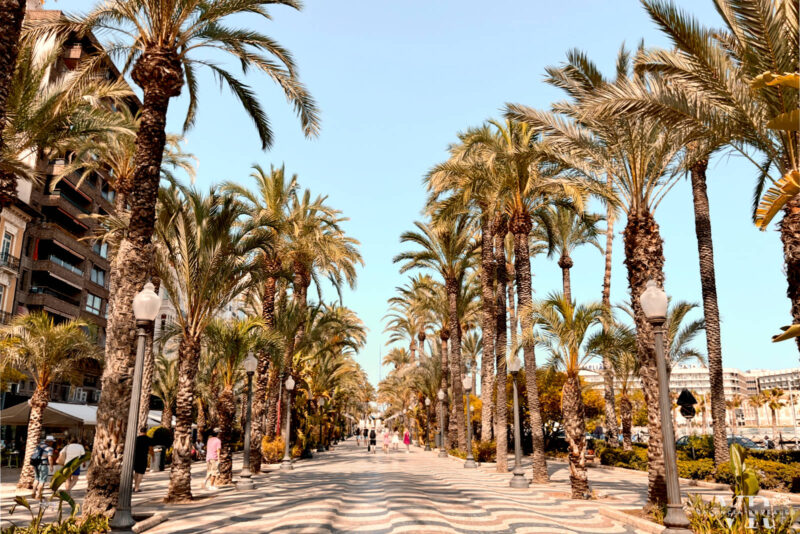
Alicante is known for offering good value for money when compared to Madrid or Barcelona, making it an appealing choice for budget-conscious travelers. Yet, compared to Valencia, you might feel you have fewer choices within the same budget, especially when it comes to dining out.
In terms of accommodation, Alicante has a similar number of properties as Valencia, on both Booking.com and Airbnb. While the starting rates are slightly lower, you might have to look a bit harder to find the same value for money as in Valencia, especially in terms of design and customer ratings.
Dining out in Alicante won’t break the bank either, but options are more limited and it might be challenging to find a good set lunch menu for €14 like in Valencia.
🏆 Winner: Valencia
Conclusion: Valencia vs. Alicante
Both Valencia and Alicante offer unique and enticing experiences for travelers seeking a short but unforgettable trip. While each destination possesses its own distinct charm and attractions, it ultimately comes down to individual preferences and interests.
Valencia has a rich cultural heritage, futuristic architecture, and a vibrant atmosphere. It promises a journey through time and artistic wonders and offers a balanced blend of history and contemporary fun.
Alicante caters to those yearning for a laid-back beach escape with a touch of history. Its picturesque coastline makes it an ideal spot for a relaxing summer vacation and sun-soaked days.
Ultimately, both cities have something different to offer and are alluring in their own right. Whether you pick the vibrant streets of Valencia or the serene shores of Alicante, as long as you stay true to your travel interests, you can’t go wrong with either of them.






